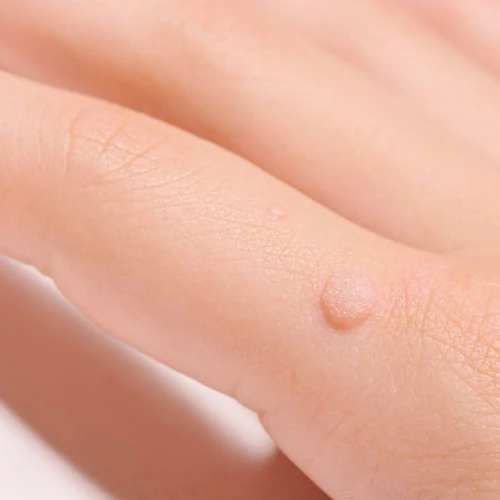Definition: what is a common wart?1, 2, 3
Common warts are some of the most common warts and are usually found on the back of the hands, fingers, elbows and knees. They can also occur around the nails and cause abnormalities. Common warts around the nails can be very painful, especially when they occur around the cuticles (thin skin at the base of the nail) or in the skin under the nail. A common wart located under the cuticle can disrupt nail growth and cause deformity.
How do you recognise a common wart?1, 2
A common wart is a single benign lesion that is rarely painful. It resembles a small skin-coloured or slightly greyish ball that is rough to the touch whose size ranges from a few millimetres to 1 cm.
Children are particularly affected by common warts, as it is estimated that 50-70% of children aged between 5 and 15 years will develop a common wart. The incidence decreases after the age of 15.
What causes common warts?4
Common warts occur after the skin has been infected by one of the human papillomaviruses (HPV) of which there are different types. These viruses penetrate into the skin through a breach (wound, dry skin, etc.) in the protective skin barrier.
How does a common wart spread?4
The viruses that cause common warts are contagious. They can be spread in several ways:
- Self-spreading. The person already has a wart and the viruses contained in the wart cells spread over the skin when the person scratches. The spread of the viruses can create new warts.
- Skin contact. An infected person contaminates another person through skin-to-skin contact.
- Indirect spreading. The viruses present in the warts of infected people are deposited on contact surfaces (tools, floors, etc.) and then penetrate into the damaged skin (cuts, abrasions, blisters, etc.) of another person when they touch these contaminated surfaces.
Who is most at risk?3, 4
The people most at risk of contracting common warts are professionals exposed to microtrauma to the skin on their hands and the skin around their nails: butchers, fishmongers, vets, gardeners, cleaners, who often have their hands in water, etc. People who bite their nails also have an increased risk of developing common warts. In addition to the increased risk of contracting common warts, people who regularly bite their nails can spread the infection from one nail to another or from one nail to the skin, or the corners of the mouth.
How do you get rid of a common wart?5, 6, 7
Skin warts often disappear on their own, especially in children. However, this spontaneous healing can take months, even years. Fortunately, it is also possible to get rid of a wart through various treatments.
Self-medication products are available.
These treatments are available over-the-counter in chemists and health & beauty stores.
Wart-removal products
These products contain salicylic acid, which is sometimes combined with other corrosive substances. Warts are destroyed through a keratolytic effect. In other words, they destroy the excess keratin. These treatments need to be applied directly to the wart. Users must ensure that the product does not come into contact with the healthy skin around the wart as this can cause burning and scarring.
Treatment should continue until the wart has disappeared completely, which usually takes 4 to 8 weeks.
Wart-removal products are contraindicated in children under the age of two years, in pregnant or breast-feeding women, in diabetics and in people with peripheral artery disease of the lower limbs.
Cryotherapy kits
Cryotherapy kits include a cold tip (-50°C) that is left on the wart for 30 to 60 seconds. The cold freezes the wart and removes it from its base.
Treatments used by general practitioners, dermatologists and pedicurists/podiatrist
If self-medication products do not manage to destroy your common wart, it's best to consult your general practitioner, dermatologist or pedicurist/podiatrist. You will then be offered a range of physical or chemical options to destroy the epidermis infected by the papillomavirus.
Liquid nitrogen cryotherapy
Cryotherapy (cold treatment) is the most common method used to destroy skin warts. Doctors use cotton-buds dipped in liquid nitrogen (which is much colder than one in the kits sold in chemists). The bud is held twice on the wart for about ten seconds. A spray that delivers nitrogen from a pressurised container can also be used. This spray in applied for 20 seconds. Although cryotherapy can be successful from the very first application, it generally takes several sessions to remove the warts completely.
Surgical curettage
This technique involves removing the wart by making a small incision under local anaesthetic and is only used for single large and/over overhanging warts. Curettage can leave a painful scar.
Laser
Lasers can be used to destroy the wart by destroying the tissues infected with the virus or by destroying the blood vessels that nourish the wart. This technique is reserved for warts resistant to other treatments.
Common warts are particularly difficult to treat as they occur in difficult-to-reach (under the nails, on the cuticle) and fragile areas. Recurrences are also common as no treatment is currently available to eradicate the viruses responsible for warts.


